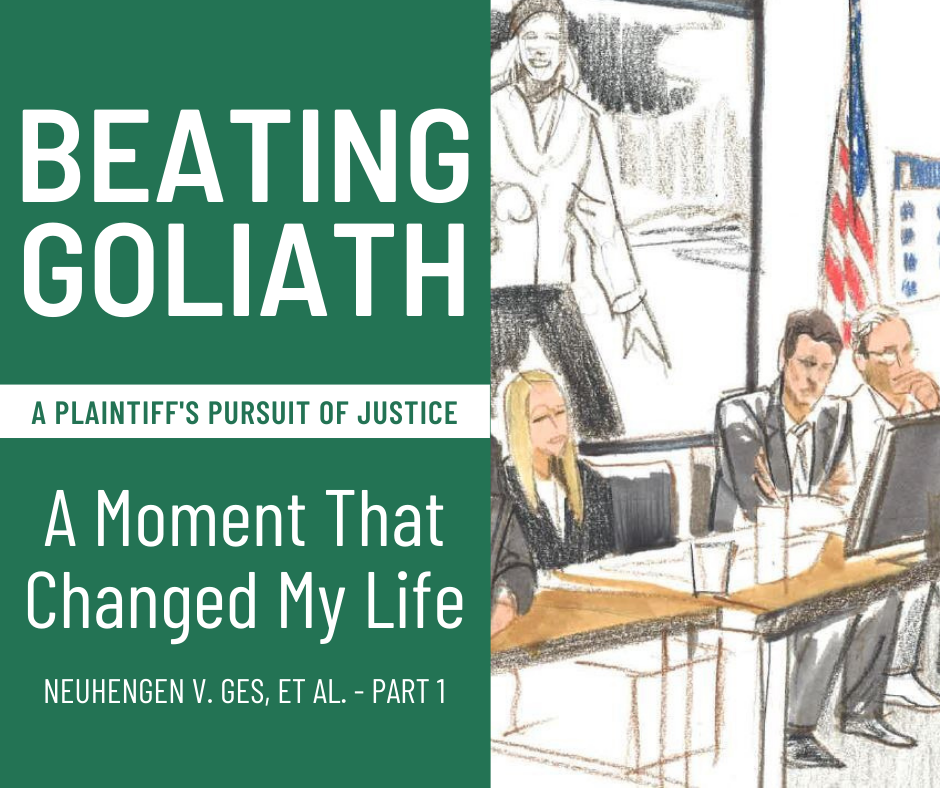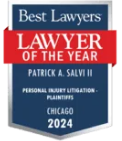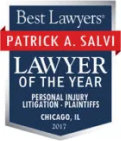
Patrick Jr: What we learn as young lawyers coming along is never to underestimate what the defense is willing to do and what they’re willing to do to protect their money. I don’t have a lot of tolerance for what I perceive to be injustice, particularly when the injustice results in somebody having physical pain and the ripple effect, that physical pain and disability can have, not just on a human being but people around them, people in their lives, their family.
Tom: I think I might have been screaming but I felt like I was kind of calm. My body was in shock. There was an ex-firefighter and I think an ex-paramedic that actually were there as well. And they came over to me and they were just like, “Hey, dude, just lay down.” So I laid down. And then obviously then started waves of pain started to happen. I was worried. I was freaked out. I mean, I was in pain. It hurt. I didn’t know what was gonna happen next.
Every minute of every day, a life is changed forever. Regular people like you and me, going to work, heading home on the bus, meeting up with friends, find themselves in unexpected situations, which then transform their futures. This is the story of one of those people. From the Chicagoland law firm of Salvi, Schostok & Pritchard, this is “Beating Goliath: A Plaintiff’s Pursuit of Justice.” I’m your host, Marcie Mangan.
Case number one, part one, Tom Neuhengen. Tom Neuhengen was working at McCormick Place Convention Center in Chicago after the completion of a trade show that involved the exhibition of machinery weighing tens of thousand of pounds. Tom’s employer was one of the exhibitors. And while heavy machines were being removed from the convention hall, a large forklift ran over Tom’s foot. This is the story of Tom’s pursuit of justice.
Tom: I grew up in Palatine, Illinois. I moved to Wisconsin in 2001. I’ve been here ever since. I used to work for a machine tool builder. Now I work for the National Guard full time as an IT Representative.
Tom Neuhengen has always been someone who has really embraced life.
Tom: Hobbies, I like going to Packer games. I like visiting with family. I like hanging out with friends. I’m actually starting to get more into fishing. I ride bikes a lot. I do like to ride a bike at least 10 to 20 miles a day if I can.
Now married to Crystal, Tom has a history of military service.
Tom: I started out in a field artillery unit, and I was in that unit until approximately 2005, 2006. We actually deployed with that unit to Iraq in 2004. I liked being a part of something bigger than me. I enjoyed it, looking out for soldiers. Taking care of soldiers is kind of a good feeling, being a part of something bigger than you are. You’re trying to better the world in a different way. So you’re trying to do things that help. Instead of being a part of a problem, you’re trying to be a part of a solution.
Marcie: When Tom returned from his second deployment in Iraq, he continued to work part-time for the National Guard, and also started a job at Hermle, a machine tool company. He mainly worked as part of their sales team, but because of the skills he had learned in the military, he was also sent to major trade shows to help with the highly skilled operation of breaking machines down at the end of the event. On September 18th, 2012, at just 33 years old, Tom was sent to help tear down his company’s booth at a trade show at McCormick Place in Chicago, the largest convention center in the United States. It was a day that would change his life forever.
Patrick Jr.: What is these trade show?. It’s the IMTS trade show, the International Manufacturing and Tools Trade Show, IMTS. And it’s a trade show that is quite literally amongst the top two or three heaviest trade shows in the world, meaning the machinery that’s coming in and out of the trade show floor is amongst the heaviest machinery that exists on this earth. The folks executing the move-in and move-out portion of the trade show have to do so in a safe manner.
That’s Patrick Salvi, Jr., a partner at Salvi, Schostok & Pritchard, and a man who would soon be a big part of Tom’s life.
Patrick Jr.: Tom was telling me about how the trade show breakdown is chaotic. And a breakdown is basically the trade show’s over and now it’s time to move all the heavy stuff out. There are procedures, there are safe forklift operations that need to occur.
It’s important to point out the forklifts used to break down the show, they’re not the kind you or I might see at Home Depot or Target. In comparison, those forklifts are tiny. The ones being used at McCormick Place that day weigh over 60,000 pounds. They’re designed to be operated by highly trained teams, a driver and two or three spotters who constantly communicate with the driver and check that the area is free from debris or people. In the midst of the operations that day, a fairly ordinary thing happened. A canister of coolant slipped off the forks of a truck.
Tom: So I slide down, picked it up, put it back on the forks, and then I stepped back, and then as I stepped back, I felt something starting to bump me from behind. So I tried to turn my body to see what was hitting me, what I was running into.
Marcie: The driver of another forklift had decided to move without consulting his spotter, without checking it was safe to do so.
Tom: So he started swinging his back end around. So then I turned and I got kind of caught under it and I fell to the ground and my left heel got caught under his wheel. So he pulled this wheel onto my heel, and then he eventually… Now he was facing the load he was gonna go pick up. So, he then straightened his wheels on my foot.
Aaron: My name is Aaron David Boeder. I am a partner at Salvi, Schostok & Pritchard. Tom essentially had his foot run over by a 65,000-pound forklift. And as you can imagine, his foot was smashed and squeezed to the point where if we were to show the pictures, it’s horrific. The wheel, the steel wheel of the forklift went over the back of Tom’s heel, and essentially smooshed it like you would a balloon that’s full of water. So it just destroyed all the tissue and muscle underneath.
Tom: I think I might have been screaming, but I felt like I was kind of calm. My body was in shock at that time, so I didn’t feel any pain quite yet. My foot came free, so then I was like, “I think every bone in my foot’s broken. Someone call the paramedics now. Somebody call the paramedics now.” There was an ex-firefighter and I think an ex-paramedic that actually were there as well. And they came over to me and they were just like, “Hey, dude, just lay down.” So I laid down and then obviously then started waves of pain started to happen as I’m sitting there.
Marcie: Despite being in intense pain, Tom’s mind was still on his work
Tom: It was funny, when the paramedics came, I was still trying to talk to my colleague to be like, “All right. All the bill of ladings are in this bag. Here’s my binder.” Even on my way to the hospital, I remember calling my boss and telling him like, “Oh, yeah, yeah, I got hit. I gave the bill of ladings to Rick. He should be able to do this, this, and this.” And he’s like, “Dude, just go to the hospital.” He was like, “Stop it.” I was worried. I was freaked out. I mean, I was in pain. It hurt. I didn’t know what was gonna happen next.
Marcie: After seeing the severity of his injury, the paramedics took Tom to Northwestern, where that night he went into the first of many surgeries. Also that night, Tom’s mom, Patricia, made a phone call, as Patrick Salvi, Jr., explains,
Patrick Jr.: Tom was, of course, laid up. He wasn’t thinking about a lawsuit or anything like that. But as frequently happens with our clients, their family members are thinking about the injured family member’s best interest and want to take the reins on things like making sure other obligations are being taken care of, or if the injured person has obligations where someone needs to be notified that that obligation won’t be met, that that’s taken care of. And along those lines, loved ones will frequently reach out to us and say, “Someone who I’m close with…” In this case was his mom who called us and said, “My son’s in the hospital. Would you come meet with him?”
Marcie: Aaron Boeder took that call.
Aaron: So I actually was the first lawyer to speak to the family. Your first phone call with a new client is first trying to understand what the case is about. Why are they calling? What happened? When did it occur? Where did it occur? Who the players might be? When I say players, I mean who are the different companies or entities that may have either employed or been in charge at the time? And I immediately reached out to Pat Salvi, Sr., Pat Salvi, Jr., and TJ Saye, our chief operating officer, and I said, “This is a case which I think we should look into very quickly. The family’s contacted us and they wanna meet today.”
Patrick Jr.: We were fortunate to get in early in order to do investigation. Because you know who always knows about the case early is the defense lawyers, because the party that is potentially responsible, the one that is looking at a situation like this thinking, “Oh, no, what’s my liability going to be?” they immediately go into protection mode. And so what they do is they tell their risk manager and they tell their insurance company and they get the lawyers out there and they get their investigators out there. And within hours of something like this happening, they have people working on what the defense is going to be.
And too frequently, and I’m not blaming the injured people for this, but too frequently, we don’t get that same opportunity because our clients are having surgery. But here, thankfully, a family member reached out and we were able to embark on our investigation very early and get a lot of good evidence early, start talking to witnesses and start digging into the facts.
And we immediately went to the hospital and we saw Tom. I come into his hospital room, and here’s this young man about the same age as me. His leg is hanging from the ceiling with a screw drilled into his leg. And In addition to that, because they were so worried about his foot having appropriate blood flow to get healing, I saw old-school medicine being used with Tom, where literally leeches, multiple leeches, were hanging off of his heel. It’s an old-school method, but still works and is used to promote blood flow. And so, blood-full leeches were hanging on his heel. One fell to the ground. I mean, it was quite a sight.
Marcie: Meeting a client as soon as possible after they’ve sustained an injury isn’t just important in terms of collecting evidence, but in getting to know them as a person and starting to build a relationship.
Patrick Jr.: And I knew right away that Tom was a fighter. I knew that right away Tom was an upstanding guy. I had already heard from his mom that he was a veteran of war. This was a guy that he did the right thing. It’s the kind of person he is. It’s the kind of person that I’ve come to know him to be. I could tell, yes, he was in pain but he wasn’t gonna have a “woe is me.” He wasn’t acting like, “Feel bad for me.” No, he was telling me what happened. He was giving me the facts. He was doing exactly what he would do in his job at Hermle. He was doing exactly what he would do when he was at war. This is a guy that did two deployments to Iraq. This is a guy that had to essentially create perimeter security for other folks in the army, in the U.S. Army, while in the country of Iraq so that they don’t get killed by a bomb, so that they don’t lose a limb because there’s some sort of booby trap somewhere. So that was his responsibility. You can’t do that unless truth and transparency and detail-oriented thinking is part of your DNA.
Marcie: Patrick and the team also had to get started learning every intricate detail they could about a complex working environment.
Patrick Jr.: And I knew from the beginning that there were problems with what was going on in this industry and with what happened that day that led to Tom’s injury. There are procedures. there are safe forklift operations that need to occur, and I had to learn all that. But there was an excitement and a burning desire from Tom’s attitude and Tom’s severe injury that led us to go out and make sure that we had an incredible grasp not just of the facts, but also of the industry, and also of forklift operations. That was gonna be essential. And so that’s when we went to work.
Marcie: Of course, it was Tom’s decision to go ahead with the case.
Tom: Pat explained basically everything to me, and in layman’s terms. So it actually made sense. It wasn’t like just a whole bunch of legal jargon and I was getting confused. They made me feel comfortable. They definitely too gave me space. They even said, they were like, “Hey, you know, we’ll take care of this stuff. You worry about trying to get better. You just need to do that.” I just didn’t want that to happen anybody else. And in fact, even after the accident happened, that guy still went back to work. And then the next day, he spent the whole day on the fork truck moving more stuff around. It just added up, and I’m just like, “You know what? The only way they’re gonna learn is if they end up having to pay for it.” And that was why I went down this road.
Marcie: With a case as complex as Tom’s, there were many, many avenues that needed to be explored while preparing for trial.
Patrick Sr.: My name is Patrick K. Salvi, Sr. I am the managing equity partner for Salvi, Schostok & Pritchard, a Chicago personal injury law firm with 18 lawyers. In this particular case, I think we had four lawyers involved during the discovery aspect of the case. Three lawyers sat at counsel table for the trial. We divide things up. It’s usually in accordance with certain aspects of the case. Patrick, my son, was primarily responsible for presenting the at-fault aspect of it. Another lawyer kind of aided him in that. And then my main job was to present the damages and calling the doctors, the vocational people, the economist, lay witnesses who are gonna support the damages.
Patrick Jr.: So, with Tom, one of the things that really got us off and running was the fact that there was an OSHA investigation. So, OSHA, the Occupational Safety and Health Administration of the federal government, there are regulations. There are rules. And when an incident like this occurs frequently, they’ll go in and they’ll investigate, and they’ll see if there were any rules that were broken. And if there were, then perhaps fines or other reprimand will occur.
And so what happened was OSHA was investigating this particular instance. And I was able to get in touch with the OSHA investigator and early on learned that the forklift operator that was operating at the time that Tom’s foot got run over, and so ultimately the defendant in this case, I learned that he wasn’t certified as a forklift operator. That’s, as you can imagine, a big no-no. You have to have training and certification that…anybody operating a forklift needs to have training, evaluation, training on workplace-specific hazards, training on forklift-specific hazards, lecture-type training, hands-on-type training, evaluation by a trained and experienced operator in order to ensure that the individual being certified can do so safely out in the field. And so that never happened with this particular individual, and I found that out early.
I didn’t know much more about the defendant yet. That was yet to come. I was about to learn a lot about this defendant, this forklift operator, but what I knew from the beginning is he wasn’t certified. That struck me as very, very wrong. I wanted to figure out why that happened. How could, at this show, one of the biggest in the world rivaling shows that are put on in Germany where literally machinery that are hundreds of thousands of pounds are being moved by cranes and massive forklifts, huge machinery, how could it be that there’s a forklift operator at this show doing the move-out phase of the show, and isn’t forklift certified? That was something that needed some further investigation. And so we embarked on that journey.
Marcie: As Tom’s legal team started to work hard to get him justice, he was facing a daily battle with multiple surgeries, extensive physical therapy, and intense pain.
Tom: Came out of surgery, woke up, and I had basically a T handle in my shin. Think about, like, a piece of metal with a T at the end. I remember Dr. Alghoul on Dr. Dumanian coming and seeing me. Basically, they were like, “Hey, so we got two options here. All right? So one, we can do an amputation. You will get as good as you can much faster. It might take you a year to learn how to walk on a prosthetic, and then you’ll be as good as you can get with that prosthetic. The second option is we can do what’s known as a free flap. So basically, we take a quad from your leg and we build you a new heel.”
So basically, he explained that the heel of my foot had died. So that soft tissue, the pad of my foot basically died. You could literally take the heel of my foot, just the soft tissue, not the actual bone, the heel of my foot and put it on the top of my foot. There was nothing connecting it really anymore. So the other option was to do what was known as the free flap. Basically, they take that tissue, build it onto my heel, and then they’ll do skin grafts and then rebuild that pad for myself.
Some of the questions I had with that…because I still wanted to stay in the army. My whole goal was to still be in the military. And so then I was like, “All right. Well, will I be able to run again, be able to somewhat run?” And he was like, “You should be able to walk without a problem.” I’m like, “And that’s without aid, right? I won’t need a cane or anything like that?” He’s like, “Yep, you should be able to walk without problems at some point. Walk, if not even run at some point.”
He did tell me that it’s a very long recovery process. He said it could take three to four years before I can actually start feeling like I’m somewhat normal again. And I mean somewhat very loosely. So I had to take that into consideration. And so I was like, “All right. Well, if I can do all that, then I’d like to just…let’s go for it. Let’s give this a shot. Let’s do the free flap surgery.”
That one there was the one that caused me the most pain. I woke up in the ICU. I would scream until I couldn’t scream anymore and then I’d pass out. And I’d wake up and go all over again. And I don’t know how long that went for, but that’s basically how, like, that first day kind of went.
Marcie: The free flap surgery was only the first stage and Tom’s recovery. The heel on his reconstructed injured foot was so huge he would have to cut out the back part of any shoes he bought in order to get them on. He actually went on to have seven highly complex surgeries in total in two separate hospitals.
Dr. Law: My name is Brian Law. I’m an associate professor of Orthopedic Surgery at the Medical College of Wisconsin, specializing in foot and ankle surgery. I’m also the fellowship director for the foot and ankle fellowship. So Tom had a crush injury to the back of his foot and his heel. He ended up losing all of the skin, fat, muscle, and everything off the back of his heel and around his ankle. So down in Northwestern, to treat that, they placed a free flap. So they took some muscle from another part of his body along with the blood supply and plugged it into the blood supply down in his foot to cover the big wound so that the bone wouldn’t be exposed.
Because his foot had been immobilized for so long because they needed this free flap to grow in place and become stable, his ankle was stuck pointed downwards as if he was standing on his toes all the time. As you can imagine, that’s really hard to walk and to maintain kind of a good position of your leg when you’re standing on your toes constantly, unless you’re gonna be wearing high-heeled shoes for the rest of your life. So when I saw Tom, that was really what our major concern was, that he couldn’t stand and couldn’t walk.
When he first showed up to us, he couldn’t put any weight on his foot. He hadn’t been able to walk or stand. Once we were able to get him into physical therapy and really get him working in putting weight on his foot, it really started to stretch things out. We knew that there was a lot to recover and we weren’t sure how much we would be able to recover just with physical therapy. But we wanted to try that first before taking him to surgery. Anybody who sustains this kind of injury needs to remember is that they’re never gonna be 100% normal. They’re never gonna be exactly the way that they were before their injury.
Marcie: Ultimately, Dr. Law did need to perform more surgery on Tom, lengthening his Achilles to allow him to be able to place his foot on the floor. It was a surgery that was extra complicated because of the extensive work Tom had already gone through. And of course, it also led to more physical therapy. But again, Tom’s strength of character shone through.
Dr. Law: I tell patients all the time that what I did was the easy part. The hard part is the recovery. He’s a very good patient. There are a lot of patients who aren’t as motivated, who aren’t as willing to push themselves through therapy and get themselves walking again. But Tom was a very motivated person who really wanted to be a normal guy.
Marcie: The fact that Tom was a regular guy who just wanted to lead a normal life and was now facing a life of pain, through no fault of his own, was something that deeply affected Patrick.
Patrick Jr.: With Tom, there was the added element of Tom and I being about the same age. We’re about six months apart. And so when I see someone laying in bed, in the condition Tom was in, same age as me, facing a potential foot amputation, facing multiple surgeries, facing a potentially devastating and permanent injury, it’s hard for me to feel anything other than just absolutely broken up.
Some lawyers may not think this is the best approach, but whether it’s just my inability to do so or the fact that I’m okay being expressive, I don’t hold my emotions back all that much. I’ve had plenty of times when I’ve sat and I’ve cried with clients. I’ve sat and I’ve tried to just be there for them in whatever way, whether it’s just to be there physically and provide support or to talk to them, whatever the case may be. And the same with Tom. I spent a lot of time with him in the hospital. I spent a lot of time with him at his home. And so whenever Tom and I would talk about his injury, I always wanted to make sure I was very sensitive to the fact that, here I am, the same age as Tom, able to play sports, able to, you know, pick up my kid and run upstairs, do all these things that Tom will never be able to do normally, that can’t do anything but touch you if you’re in my position and motivate you. And that’s how I would always look at it, as motivating, that we’re gonna hold these folks accountable. So we’re gonna take this negative and we’re gonna try to make it a positive as best we can. We’re gonna get you the care that you need. We’re gonna make sure the world knows that this behavior, that this conduct is unacceptable. We’re gonna make some positive change happen. And we did.
Marcie: But just before the trial was due to begin, Patrick got a call from the defense team. They wanted to make Tom a financial offer to make the trial go away. And it was an offer that Tom had to consider carefully.
Patrick Jr.: You don’t know from the beginning if the case is gonna be tried or not, because at any point in time, the defense could offer an amount of money that is something that the client just simply cannot risk turning down, and then a settlement happens. But in this case, the defense offered $5 million. And so, we thought about what that kind of money meant for Tom, and in light of his youth, in light of the fact that this injury threatened his ability to work, and we knew that it was a lifetime of pain and disability, and that he would have additional medical expenses on top of the nearly half a million dollars of medical expenses he already had. And so when you put it in that context, $5 million is a lot of money, but it didn’t begin to compensate Tom for what he had gone through and what he was going to go through. And it was an amount of money where they were happy to pay it because then they could just swipe this under the rug and they wouldn’t have to feel really too much pain. And so, we didn’t wanna let that happen.
Tom: When I talked to Pat, Pat kind of explained that, “I do think your case is worth a lot more than this.” And FYI too, you know, the amount that they were offering was like a drop in the bucket for them. It wouldn’t hurt them at all. They’d literally be like, “All right, cool. This is all I gotta pay to get out of this? Here you go. I’m fine.”
Patrick Jr.: And they would have felt like they did a good job. That wouldn’t have effectuated the type of change that Tom and I and our team wanted to effectuate. And quite frankly, that amount of money would not have taken care of Tom and compensated him for the extent of his severe injuries.
Marcie: In the next episode of “Beating Goliath: A Plaintiff’s Pursuit of Justice,” the trial begins and the defense goes on the attack.
Man: Tom shouldn’t have been there, shouldn’t have been doing what he was doing. He was out of sight. It’s his fault that he got run over by this forklift.
Patrick Jr.: He knew the forklift was there. He knew the forklift was moving and was in the blind spot and put himself in harm’s way.
Tom: Like, even during my testimony, the opposing counsel was basically almost like trying to throw me under the bus I felt like, or basically putting words in my mouth.
Marcie: Special thanks to Tom Neuhengen and all the experts and attorneys who took the time to talk to us. Thank you as well to our production team at Lemonpie. “Beating Goliath” was written and produced by Sam Walker, editing and sound design by Eric Sirianni, and executive producers are Katie Bush and Erik Jacobson. To find out more, head to salvilaw.com/podcast. I’m your host, Marcie Mangan. Thank you for listening.









